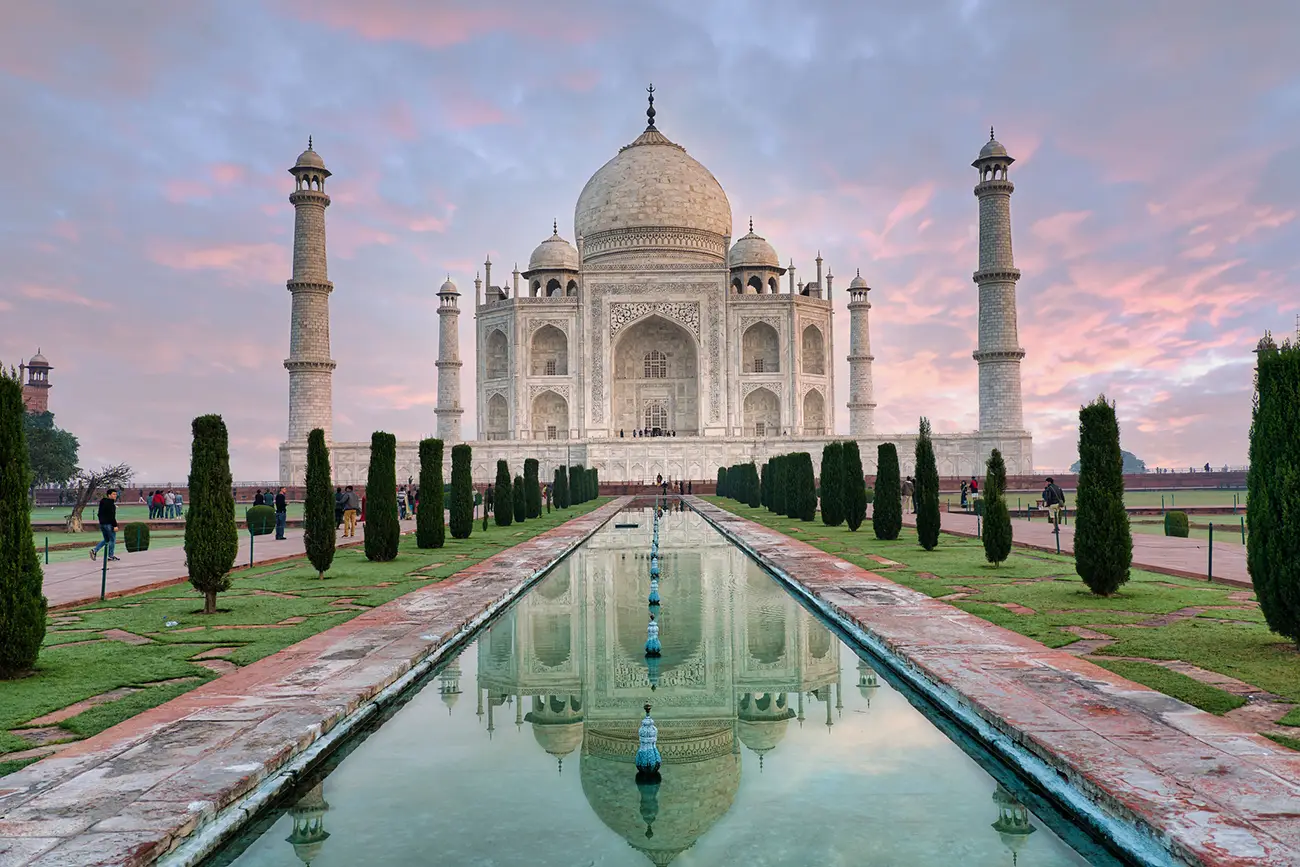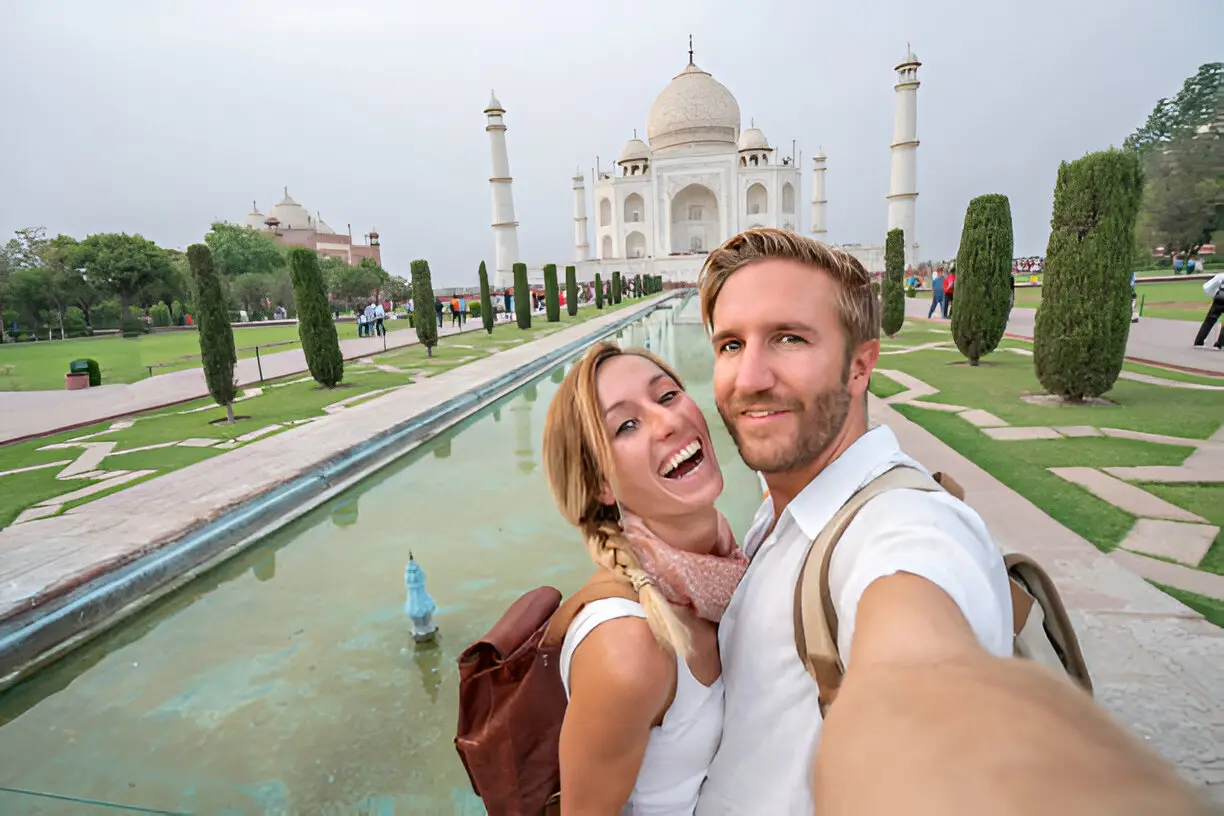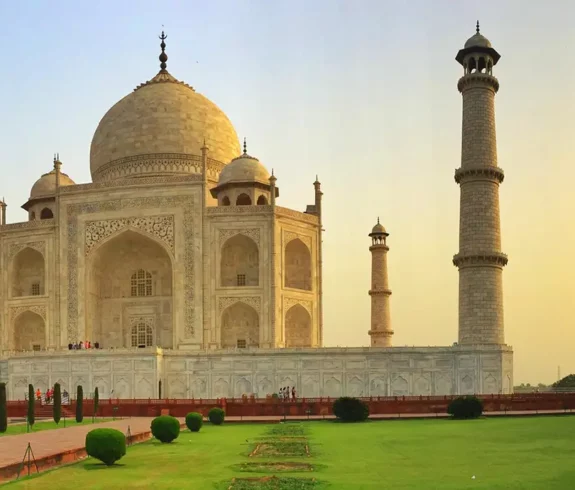In Agra, on the serene banks of the Yamuna, the Taj Mahal greets the sunrise, appearing as a magnificent white marble dream. Its elegant dome and soaring minarets glow in golden light. In the early morning, the marble facade looks pink; at midday, it gleams pure white, and at sunset, it turns a warm golden color. Emperor Shah Jahan erected this famous structure in a loving tribute to his wife, Mumtaz Mahal. The Taj Mahal, Agra, is celebrated worldwide as a symbol of love and an example of India’s rich heritage. In 1983, UNESCO recognized it as a World Heritage Site. Today, millions of people visit each year to walk through its tranquil gardens and admire its shining dome.

Historical Context
Tragically, in 1631, Mumtaz Mahal, Emperor Shah Jahan’s esteemed consort, died after giving birth to their fourteenth child. Heartbroken, Shah Jahan built a grand tomb to honor her memory. Construction began in 1632 under architect Ustad Ahmad Lahori.
It took about 21 years to complete the complex. By 1648, the main white marble mausoleum was finished, and in 1653, the surrounding buildings and gardens were done. About 20,000 craftsmen and laborers from India, Central Asia, and Persia worked on the project, using white marble from distant quarries.
Shah Jahan lived long enough to see his beloved Taj Mahal nearly complete. Later, his son Aurangzeb placed him under house arrest in Agra Fort across the river. 1666 Shah Jahan died and found his final resting place alongside Mumtaz Mahal under the Taj’s iconic dome.
Due to its remarkable beauty and significant cultural value, the Taj Mahal was proclaimed a World Heritage Site by UNESCO in 1983. It is often called a jewel of India’s cultural heritage. Many visitors see its beauty and feel the romance of Shah Jahan and Mumtaz Mahal’s story.
Architectural Features
Design and Layout of the Taj Mahal
The Taj Mahal’s design is a masterpiece of Mughal architecture, representing a harmonious fusion of Persian, Islamic, and Indian influences. The entire complex is perfectly symmetrical on its north-south axis. At the center is the main mausoleum, which is made of smooth white marble. It sits on a raised square platform with chamfered corners, giving it an octagonal shape. The building’s four sides are identical, each with a large arched doorway. Black marble inscriptions of Quran verses decorate the arches. The white walls gleam in the sunlight, and carved floral patterns accent the marble surfaces.
The Taj complex covers about 17 hectares (42 acres), including its gardens and buildings. Unusually, the tomb is placed at the north end of the garden rather than in the center. This layout creates a long view for visitors as they approach the southern gateway.

Domes and Decoration
Rising from the center of the main building is a large, onion-shaped marble dome. This central dome is almost 35 meters high, which is the most striking feature. It is topped by a gilded finial that combines Islamic and Hindu decorative motifs. Four smaller domed kiosks (called chhatris) stand at each corner of the roof, echoing the shape of the central dome.
Four slender minaret towers rise at each platform corner, framing the Taj. Each minaret is over 40 meters tall and leans slightly outward – a safety design in case of collapse. Open marble balconies and small chhatris top these minarets.
Inside the tomb chamber, the false stone tombs (cenotaphs) of Mumtaz Mahal and Shah Jahan rest under the dome. The graves lie in a crypt below and are not visible to visitors. Richly adorned, the interior’s walls and pillars showcase intricate floral motifs formed by inlaid semi-precious stones. This inlay work, Pietra Dura, uses stones like lapis lazuli, jade, and agate to create flowers and vines in the marble. It covers many parts of the building, especially around the entrance arches and the cenotaphs.
Gardens and Surroundings
The Taj Mahal sits amid a classic Mughal Charbagh garden. This formal garden is divided into straight walkways and water channels. A long reflecting pool runs along the central axis from the gateway to the tomb. On calm mornings, the still water mirrors the image of the Taj on its surface. Fountains line the pool, adding movement and coolness to the scene.
The garden has green lawns, flower beds, and rows of cypress trees. It was designed to represent a paradise garden. The whole setting adds to the calm and spiritual feeling of the monument.
Red Sandstone Mosque and Guesthouse
On the main mausoleum’s west side stands a red sandstone mosque. This mosque has a large prayer hall and three marble domes, facing west toward Mecca so that the emperor could lead prayers there. On the east side is a nearly identical building called the jawab (meaning “answer”). The jawab was built only to maintain perfect symmetry and was likely used as a guesthouse or assembly hall. Both buildings match each other in size and design. Their warm red sandstone color provides a striking contrast to the white marble of the tomb.
The Grand Gateway
Visitors enter the Taj Mahal grounds through a grand gate called the Darwaza-i Rauza. This gateway is a massive red sandstone structure with a large central arch. It is richly decorated with marble inlay and verses from the Quran in black marble. When you pass through this tall, arched gate, the Taj Mahal suddenly comes into full view. The gateway perfectly frames the white monument. Many say that this first glimpse of the Taj Mahal through the arch is one of the most memorable moments of a visit.
Visitor Experience
Visiting the Taj Mahal is often an emotional experience. Many people are speechless when they first see its perfect symmetry and gleaming marble. The peaceful gardens and reflecting pool add to the calm feeling. Tourists often think about the love story of Shah Jahan and Mumtaz Mahal as they stand in this historic place. On clear mornings, the Taj can seem to float in mist, while its marble walls can glow pink or orange at sunset. Throughout the day, the atmosphere remains calm and respectful.
Best Visiting Times
- Sunrise: Early morning is very popular. The marble reflects the soft dawn light, often with fewer visitors around. The air is cool, and the light is gentle.
- Sunset: Late afternoon light gives the Taj a golden or reddish glow. The heat of the day eases, making the visit more comfortable.
- Full Moon Nights: The Taj opens for special night visits on full moon nights (the 13th and 14th lunar days, except Fridays). By moonlight, the marble dome and walls appear silver-blue. These nights offer a magical view, but tickets are limited and must be booked in advance.
- Midday: The sun is high and bright, making the marble look white. It can be hot and more crowded around midday. If you visit, wear a hat or carry an umbrella for shade.
Photography and Conduct
- Photography: Taking photos is allowed on the grounds. Good spots include the main gate, the central water channel, and the reflecting pool to capture the Taj and its mirror image. Try to include some of the gardens or gates for context. Flash is not needed outside.
- Restrictions: Drones, professional, and video cameras are prohibited without special permission. Tripods are not permitted. Photography inside the main mausoleum (tomb chamber) is strictly prohibited.
- Footwear: Before stepping onto the white marble platform or entering the tomb, you must remove your shoes or wear the provided shoe covers. It is common to see visitors walking in their socks or shoe covers on the platform. The outer paths can be walked in regular shoes.
- Dress Code: Modest dress is expected out of respect. Both men and women should cover their shoulders and knees. Removing hats is polite when entering the tomb chamber or any prayer area.
- Behavior: Speak softly and creep, especially near the tombs. Do not touch or climb on any of the marble surfaces. To preserve this invaluable heritage site, please ensure the surroundings of the Taj Mahal remain clean and refrain from littering.
- Security: Bags are screened at the gates. Do not carry large bags, sharp items, or prohibited objects (food, tobacco, alcohol, etc.). Keep your belongings with you. If you feel unwell, there are benches and rest areas along the pathways.
- Guides: Official and audio guides (with visible ID badges) are available if you want more information. Hiring a licensed local guide can enrich your visit with stories and history, but it is optional. Always ensure any guide has proper identification.

Travel Information
Location and Access
The Taj Mahal is in the city of Agra, Uttar Pradesh. Agra is about 230 kilometers (around 140 miles) south of New Delhi. The city is well connected by road, rail, and air:
- By Train: Fast trains from Delhi (such as the Gatimaan Express or Shatabdi Express) take about 2–3 hours to reach Agra. These trains arrive at Agra Cantonment (Agra Cantt) or Agra Fort railway station. Booking tickets in advance is recommended.
- By Car/Bus: Driving or taking a bus via the Yamuna Expressway usually takes 3–4 hours from Delhi. Several private and government buses run daily.
- By Air: Agra has a small airport for domestic flights. A flight from Delhi takes about one hour, but you must also allow time for travel to and from the airports.
Once in Agra, the Taj Mahal is about 5 km from Agra Cantt railway station and 6 km from the central bus station. Most visitors hire a taxi or auto-rickshaw (three-wheeler) for the short ride to the monument. Battery-operated rickshaws and horse-drawn carriages are also available near the gateways. Many hotels and tour companies can arrange transport; ask your hotel for a trusted driver or guide to avoid haggling and ensure a fair price.
Entry and Tickets
Visitors enter the Taj Mahal through either the Eastern or Western Gate. (The Southern Gate is used only as an exit.) At each gate, you will find ticket counters. Foreign tourists and Indian citizens use distinct queues for entry. You can acquire tickets by paying with cash or a card at the counter or by booking them online to expedite your entry. You must show a valid photo ID at the ticket window (a passport for foreign visitors or a government ID for Indians).
The entry ticket gives access to the gardens, the mausoleum platform, and the surrounding area. There is an additional fee to enter the main mausoleum chamber where the cenotaphs are located. Children under 15 are usually admitted free or at a reduced price (check current rules). Please keep your ticket with you, as guards may check it multiple times.
Opening Hours and Tips
- Hours: The Taj Mahal opens 30 minutes before sunrise and closes 30 minutes before sunset.
- Closed Days: The monument is closed to visitors every Friday (it is open for Muslim prayer services in the mosque on Fridays). Plan your visit for another day.
- Night Viewing: Special night visits are allowed only on full moon nights (excluding Ramadan) and the two nights before and after (five nights total per month). These tickets must be bought separately in advance.
- Arrival: Many travelers aim to arrive right at opening time to avoid crowds and the heat. Late afternoon (an hour or two before closing) is another good time for pleasant light and cooler weather.
- What to Carry: Bring water, sunscreen, sunglasses, and a hat (it can get very sunny). Small snacks should be eaten outside. Carry a small bag or purse; large backpacks may be prohibited or take longer to check.
- Safety: The area around the Taj Mahal is generally safe, but standard precautions are required. Keep an eye on your belongings in crowded spots. Avoid accepting offers from touts or hawkers for extra services you did not arrange. Carry some cash and your hotel name and address.
Other Agra Attractions
While in Agra, visitors often explore nearby historic sites:
- Agra Fort: A massive red sandstone fortress only a few kilometers from the Taj. Inside are palaces, mosques, and gardens that once served the Mughal emperors. You can catch a side view of the Taj Mahal across the river from the fort’s walls.
- Itimad-ud-Daulah (Baby Taj): A smaller white marble tomb north of Agra Fort, often called the “Baby Taj.” Built in the early 1620s, it features delicate marble inlay and latticework. Many historians see it as a prototype of the larger Taj Mahal.
- Mehtab Bagh: A garden complex on the opposite bank of the Yamuna River, directly north of the Taj. Shah Jahan built it to form a perfect alignment with the Taj. It now serves as a peaceful park, presenting one of the best opportunities to witness the Taj Mahal at sunset, beautifully reflected across the water.
Agra is also known for its markets (such as Kinari Bazaar for handicrafts) and Mughlai cuisine. However, the Taj Mahal is the highlight for most travelers, so plan extra time to enjoy this one destination fully.
Closing Thoughts
The Taj Mahal in Agra is India’s architectural and historical masterpiece. Its stunning marble dome and serene gardens will leave every visitor speechless. When you’re standing right there, it’s easy to connect with the sheer artistry and the poignant tale of love woven into its very fabric. Any tour of India feels incomplete without a visit to this iconic monument. A little preparation and respect for the regulations will ensure an unforgettable experience at the Taj Mahal. Once you have seen the Taj Mahal at dawn or dusk, its image will remain in your memory long after your tour ends.
